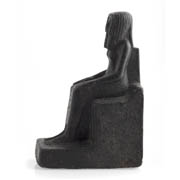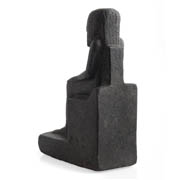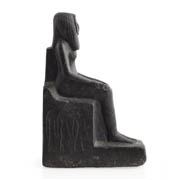Details
- Object type
ka statue
- Title
Ahmose
- Place Associated
Egypt (place made)
- Date
Early New Kingdom (probably) (1550-1500BC)
- Materials
granitoid
- Dimensions
overall: 293 mm x 93 mm x 192 mm 6558 g
- Description
-
Ancient Egyptians believed they could enter a new life after death in this world which led them to create monuments, temples, tombs and artworks to help maintain their existence in the Afterlife. One of the tenets of their belief was that their human physical and spiritual body split after death into five parts. One of these parts was the ka which often described as the spirit of a person. This part could travel freely through the world but required a home at night. A ka statue was placed in the tomb so the ka could inhabit it. The name of the dead person would usually be inscribed on it too.
In this case, the name of the dead woman Ahmose is given and she is described as “justified” or “true of Voice”. This refers to the Ancient Egyptian belief in the requirements needed to pass into the Afterlife. Part of the process involved a ceremony called the Weighing of the Heart where a deceased person’s actions in life were judged by the gods. If this test was passed, the dead person was given the epithet of “maat-kheru” and allowed to enter the next world.
Provenance: James Reddie Anderson, Keswick; Sotheby’s 20-21 December 1948; Sydney L Moss from whom purchased by Sir William Burrell on 20 December 1948.
- Credit Line/Donor
Gifted by Sir William and Lady Burrell to the City of Glasgow, 1944
- Collection
Burrell Collection: Egyptian Items
- ID Number
13.149
- Location
Burrell Collection




